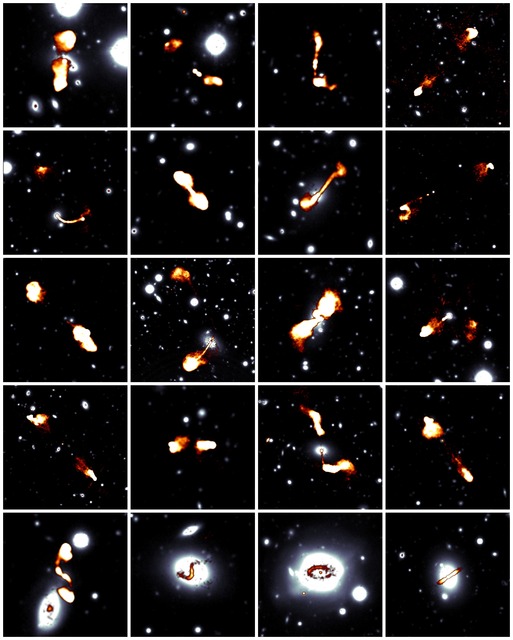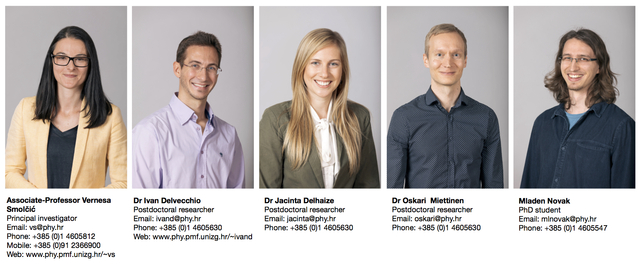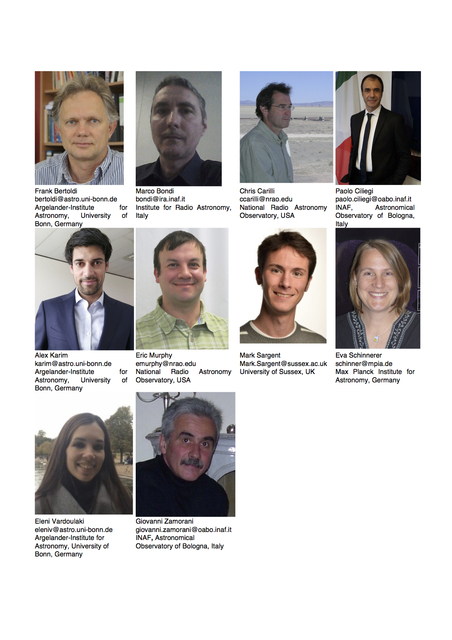The VLA-COSMOS 3 GHz Large Project - Deep space studies with a new radio sky survey
An international team of astronomers has conducted a powerful new survey of the sky at radio wavelengths. This has provided some of the most advanced data with which to examine the life-cycle of galaxies over the past 13 billion years of the universe’s history.
The VLA-COSMOS 3 GHz Large Project, led by researchers at the University of Zagreb, is a radio survey of a two-square-degree patch of sky called the COSMOS field. The team observed this field for 384 hours with the Karl G. Jansky Very Large Array (VLA) telescope in New Mexico, USA. This resulted in one of the clearest (highest angular resolution) and deepest (most sensitive) radio images ever produced over such a large region of the sky. In the radio ‘sky map,’ the team detected nearly eleven thousand galaxies.
“The radio light from a galaxy can show us at least two very important things,” said the lead investigator of the project, Associate-Professor Vernesa Smolčić from the University of Zagreb. “Radio light helps us to see straight through dust clouds and so reveals new stars forming within galaxies. It can also show us highly energetic signatures of growing supermassive black holes.”
This survey, and several of the key scientific findings, will be presented in an upcoming VLA-COSMOS special issue of the Astronomy & Astrophysics journal. The journal has also issued a press release, which can be seen here.
The astronomers combined the new radio data with optical, infrared, and X-ray information from many of the world’s leading telescopes. “The synergy of sensitive, multi-wavelength data allowed us to investigate the properties of galaxies shining at radio wavelengths out to about 13 billion years into the universe’s past,” said Associate-Professor Smolčić.
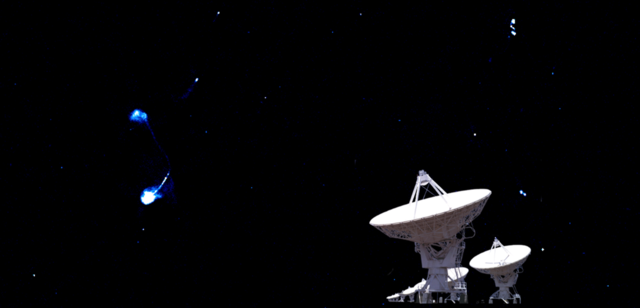 Image 1: Radio (3 GHz or 10 cm) color image showing an area of the COSMOS field containing several large radio galaxies. Also overlaid is the Very Large Array. Image credits: VLA - http://images.nrao.edu/Telescopes/VLA/9; Image courtesy of NRAO/AUI. VLA 3 GHz data - VLA-COSMOS 3 GHz Large Project mosaic published in Smolčić et al. (2017). Image composition: Vernesa Smolčić.
Image 1: Radio (3 GHz or 10 cm) color image showing an area of the COSMOS field containing several large radio galaxies. Also overlaid is the Very Large Array. Image credits: VLA - http://images.nrao.edu/Telescopes/VLA/9; Image courtesy of NRAO/AUI. VLA 3 GHz data - VLA-COSMOS 3 GHz Large Project mosaic published in Smolčić et al. (2017). Image composition: Vernesa Smolčić.
Radio light is not blocked by the large clouds of interstellar dust that often reside in galaxies. This means that radio waves can be used to detect newborn stars within galaxies in a way that is not possible at other wavelengths of light. The astronomers used the new survey to examine how the amount of radio light coming from a galaxy relates to the rate at which the galaxy is forming new stars. They also studied how this rate has changed over the history of the universe.
They found that this rate of production of new stars was the highest when the universe was about 2.5 billion years old - a fifth of its current age. During that period, about a quarter of all newborn stars were being created in massive galaxies. They also found that 15-20% more star formation was occurring in galaxies in the early universe, compared to what was previously thought. This means that dust clouds are indeed likely to be hiding many newborn stars.
The new observations carried out by the team revealed that very distant galaxies with intense, on-going star-formation (called submillimeter galaxies) are bigger, when viewed at radio wavelengths, than previously expected. The reason for this remains unknown, however it could be linked to collisions and gravitational interactions between galaxies.
The new radio survey has also provided a unique insight into galaxies containing actively growing supermassive black holes in their centers. These galaxies are called Active Galactic Nuclei, or AGN for short. Matter orbiting around and falling into the black hole can release huge amounts of energy. Using the new radio data, the astronomers discovered more than 1000 AGN that look like ‘normal’ galaxies at every other wavelength. Only their radio emission signatures betray their hidden black hole activity.
 Image 2. Zoom-in images of the VLA-COSMOS 3 GHz Large Project mosaic containing large radio galaxies (top 3x3 panels), and also compact radio objects (bottom panel). Image published in Smolčić et al (2017a). Image constructed by Mladen Novak.
Image 2. Zoom-in images of the VLA-COSMOS 3 GHz Large Project mosaic containing large radio galaxies (top 3x3 panels), and also compact radio objects (bottom panel). Image published in Smolčić et al (2017a). Image constructed by Mladen Novak.
“These radio-detected AGN are particularly interesting as they may represent a population of AGN that can influence the eventual fate of their host galaxies,” said Professor Gianni Zamorani from the Astronomical Observatory of Bologna, a member of the survey team. “Physical processes associated with emission from the supermassive black hole may heat the gas in and around the galaxy, preventing the formation of new stars and halting the runaway growth of galaxies.”
The astronomers compared the AGN heating process assumed in cosmological simulations to what they detected in the new radio data. They found a strong similarity between the two. The excellent quality of the new data allowed this test to be conducted out to a cosmic time when the universe was only about 2.5 billion years old.
“The scientific findings of this new radio survey are important because they give us more information about how and why galaxies have evolved since they were formed after the Big Bang until the present day,” says Professor Zamorani.
The VLA-COSMOS 3 GHz Large Project was made possible thanks to the recently expanded capabilities of the Karl G. Jansky VLA. In turn, this survey will serve as the basis for large-scale, next-generation radio surveys. These include the upcoming VLA Sky Survey (VLASS) and those planned with the international Square Kilometre Array (SKA) telescope.
Publication details
The publications associated with the A&A Special Issue can be accessed at: www.aanda.org/component/toc/?task=topic&id=752
The press release issued by A&A regarding the special issue can be found here: https://www.aanda.org/2017-press-releases/1388
All publications associated with this press release are as follows:
1. Smolčić et al., accepted for publication in A&A, ‘The VLA-COSMOS 3 GHz Large Project: Continuum data and source catalog release’
2. Smolčić et al., accepted for publication in A&A, ‘The VLA-COSMOS 3 GHz Large Project: Multiwavelength counterparts and the composition of the faint radio population’
3. Delvecchio et al., accepted for publication in A&A, ‘The VLA-COSMOS 3 GHz Large Project: AGN and host-galaxy properties out to z<6’
4. Delhaize et al., accepted for publication in A&A, ‘The VLA-COSMOS 3 GHz Large Project: The infrared-radio correlation of star-forming galaxies and AGN to z<6’
5. Novak et al., accepted for publication in A&A, ‘The VLA-COSMOS 3 GHz Large Project: The cosmic star-formation history since z~5’
6. Smolčić et al., accepted for publication in A&A, ‘The VLA-COSMOS 3 GHz Large Project: Cosmic evolution of radio AGN and implications for radio-mode feedback since z~5’
7. Novak et al. 2015, MNRAS, 447, 1282, ‘New insights from deep VLA data on the potentially recoiling black hole CID-42 in the COSMOS field.’ https://arxiv.org/abs/1412.0004
8. Miettinen et al. 2015, A&A, 584, 32, ‘(Sub)millimetre interferometric imaging of a sample of COSMOS/AzTEC submillimetre galaxies. II. The spatial extent of the radio-emitting regions.’ https://arxiv.org/abs/1502.05854
9. Miettinen et al. 2017, accepted for publication in A&A, ‘An ALMA survey of submillimetre galaxies in the COSMOS field: The extent of the radio-emitting region revealed by 3 GHz imaging with the Very Large Array.’ https://arxiv.org/abs/1702.07527
Multimedia
All images and photos can be accessed from http://jvla-cosmos.phy.hr/pr/
Videos
Visit the COSMOS Survey You Tube channel and watch the playlist containing all the following videos.
- The VLA-COSMOS 3 GHz Large Project – Deep space studies with a new radio sky survey: https://youtu.be/G9Cs6UDHKak
(Seen at top of page)
- An intriguing alliance of infrared and radio light in galaxies – by Jacinta Delhaize: https://youtu.be/_bYVZPtDVxY
- Cosmic history of star formation – by Mladen Novak: https://youtu.be/px1ea2xHeNE
- The sizes of submillimetre galaxies revealed by radio imaging with the Very Large Array – by Oskari Miettinen: https://youtu.be/Gd-xVDHswGs
- The deepest radio eye on active supermassive black holes – by Ivan Delvecchio: https://youtu.be/MXvV7EcTDMg
Additional images
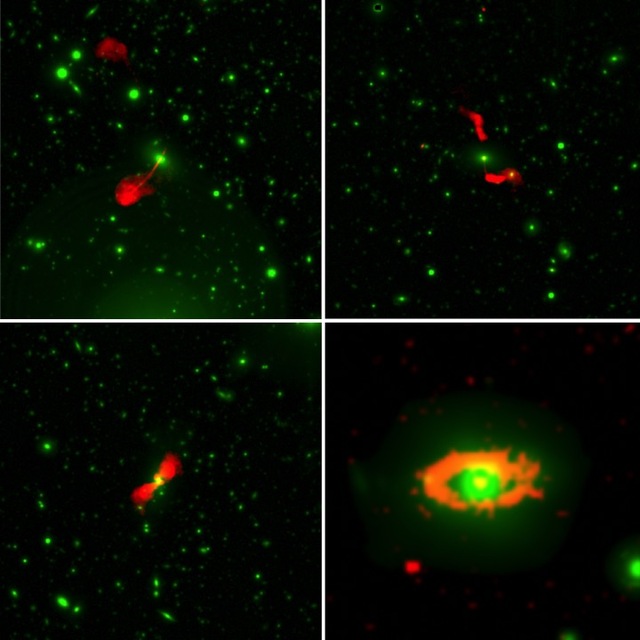 Image 3. Various large galaxies detected in the VLA-COSMOS 3 GHz Large Project, shown in false colour. In green are galaxies as seen in the near-infrared with the UltraVISTA survey. Large jets and rings are revealed in the radio images, which are shown in red. Image construction: Eleni Vardoulaki and Eric Faustino Jimenez-Andrade.
Image 3. Various large galaxies detected in the VLA-COSMOS 3 GHz Large Project, shown in false colour. In green are galaxies as seen in the near-infrared with the UltraVISTA survey. Large jets and rings are revealed in the radio images, which are shown in red. Image construction: Eleni Vardoulaki and Eric Faustino Jimenez-Andrade.
Image 4. Twenty galaxies in the COSMOS field with spectacular shapes at radio wavelengths. In the background are near-infrared images from the UltraVISTA survey, shown in white. Overlaid in a false red/yellow color scale are 3 GHz radio images of the same patch of sky. Huge structures can be seen in the radio. Image composition: Mladen Novak.
Further information
VLA-COSMOS 3GHz Large Project
• Frequency: 3GHz, wavelength: 10cm
• Survey time: 384 hours
• Sensitivity: 1σ ~ 2 μJy/beam
• Angular resolution: 0.75 arcseconds
• Sky area: 2 square degrees
COSMOS
More information on the Cosmic Evolution Survey (COSMOS) and international team can be found at cosmos.astro.caltech.edu
VLA
The Karl G. Jansky Very Large Array in New Mexico, USA, is operated by the National Radio Astronomy Observatory (NRAO). The NRAO is a facility of the National Science Foundation operated under cooperative agreement by Associated Universities, Inc.
Other data used
• Optical data from the National Astronomical Observatory of Japan’s (NAOJ) Subaru telescope
• Near-infrared data from the UltraVISTA survey with the European Southern Observatory’s (ESO) VISTA telescope
• Mid-infrared data from the National Aeronautics and Space Administration’s (NASA) Spitzer Space Telescope
• Far-infrared/submillimeter data from the European Space Agency’s (ESA) Herschel Space Observatory
• Millimeter data from the Atacama Large Millimeter/submillimeter Array (ALMA)
• X-ray data from NASA’s Chandra satellite
Lead authors of publications
Department of Physics, Faculty of Science, University of Zagreb, Croatia
ZGal group: www.pmf.unizg.hr/phy/en/zgal
 Photo: University of Zagreb ‘ZGal’ research group. Left to right: Krešimir Tisanić (PhD student), Ivan Delvecchio (Postdoctoral researcher), Lana Ceraj (PhD student), Vernesa Smolčić (Associate Professor), Oskari Miettinen (Postdoctoral researcher), Mladen Novak (PhD student), Jacinta Delhaize (Postdoctoral researcher). Photo by Petar Krajačić Vilović.
Photo: University of Zagreb ‘ZGal’ research group. Left to right: Krešimir Tisanić (PhD student), Ivan Delvecchio (Postdoctoral researcher), Lana Ceraj (PhD student), Vernesa Smolčić (Associate Professor), Oskari Miettinen (Postdoctoral researcher), Mladen Novak (PhD student), Jacinta Delhaize (Postdoctoral researcher). Photo by Petar Krajačić Vilović.
International team
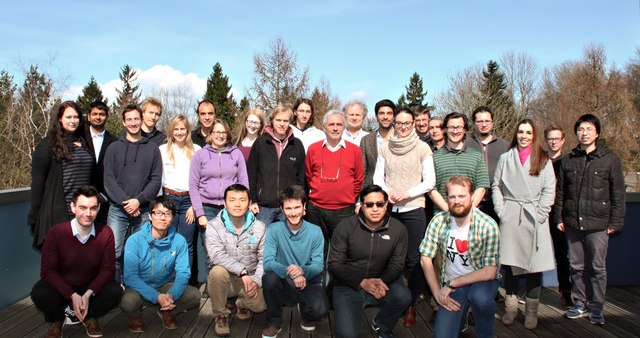 Photo: Meeting of COSMOS-VLA European core team, Max Planck Institute for Astronomy, Heidelberg, March 2017.
Photo: Meeting of COSMOS-VLA European core team, Max Planck Institute for Astronomy, Heidelberg, March 2017.
The COSMOS-VLA team includes researchers from the following institutes:
• University of Zagreb, Croatia
• University of Bonn, Germany
• Max Planck Institute for Astronomy, Germany
• University of Sussex, UK
• Institute for Radio Astronomy, Italy
• INAF, Astronomical Observatory of Bologna, Italy
• National Radio Astronomy Observatory, USA
Contact details for team representatives at these institutes are given below (click image to enlarge).
Funding
ERC Starting Grant project (‘CoSMass’): Constraining Stellar Mass and Supermassive Black Hole Growth through Cosmic Times: Paving the way for the next generation sky surveys (European Union’s Seventh Framework program under grant agreement 337595)
CIG project (‘AGN feedback’): Constraining AGN feedback through cosmic times: Paving the way for the next generation radio facilities (European Union’s Seventh Framework program under grant agreement 333654)
Deutsche Foschungsgemeinschaft (DFG): grant BE 1837/13-1 (‘The Cosmic Evolution of Black Hole and Stellar Mass Growth Probed Through Radio Observations’) and Collaborative Research Council 956 (“Conditions and Impact of Star Formation”) sub-project A1.







